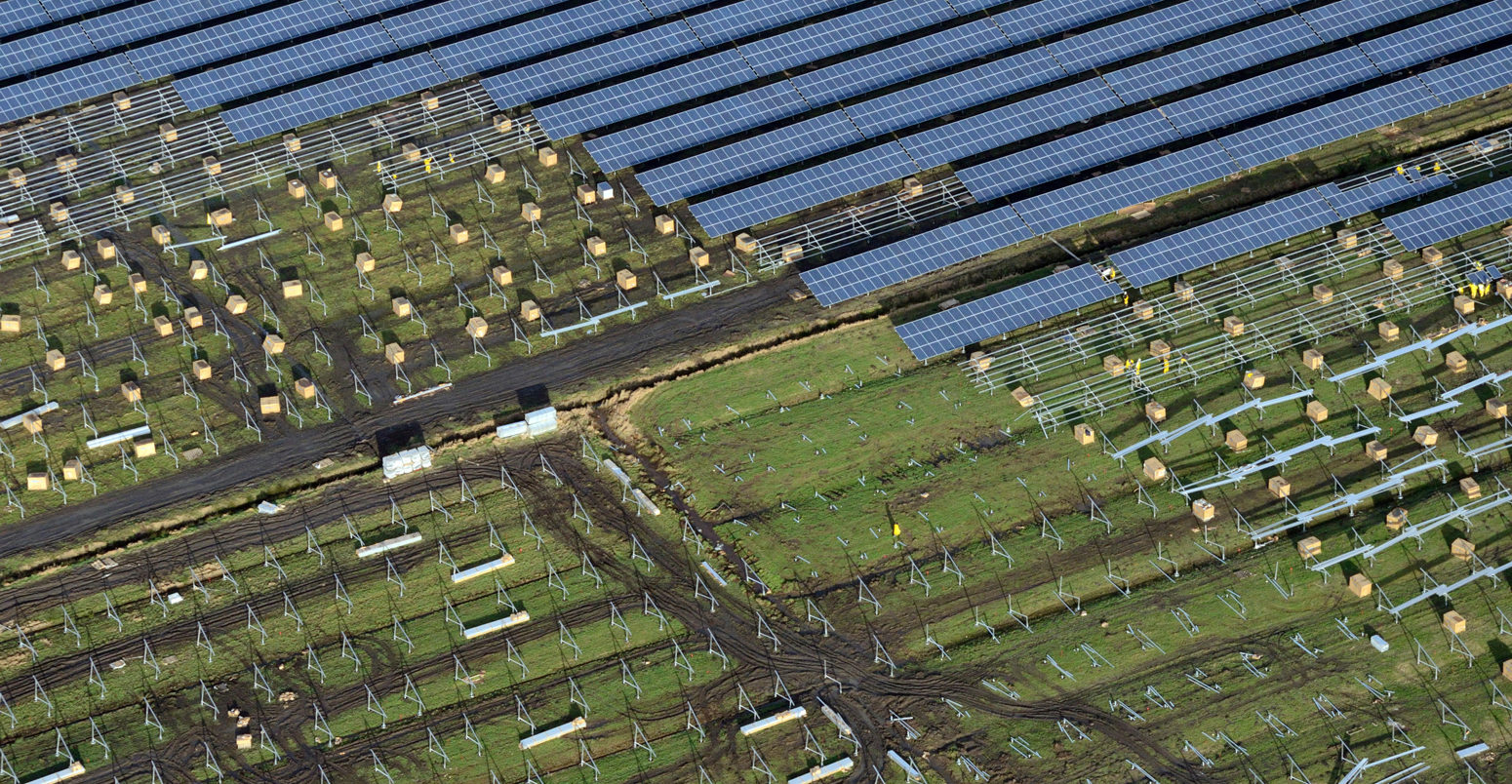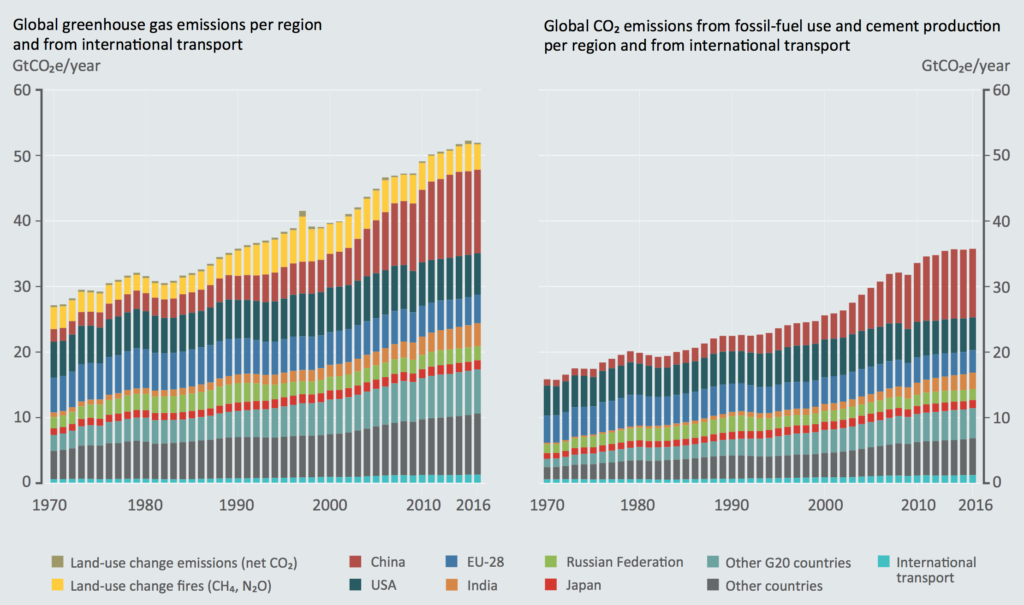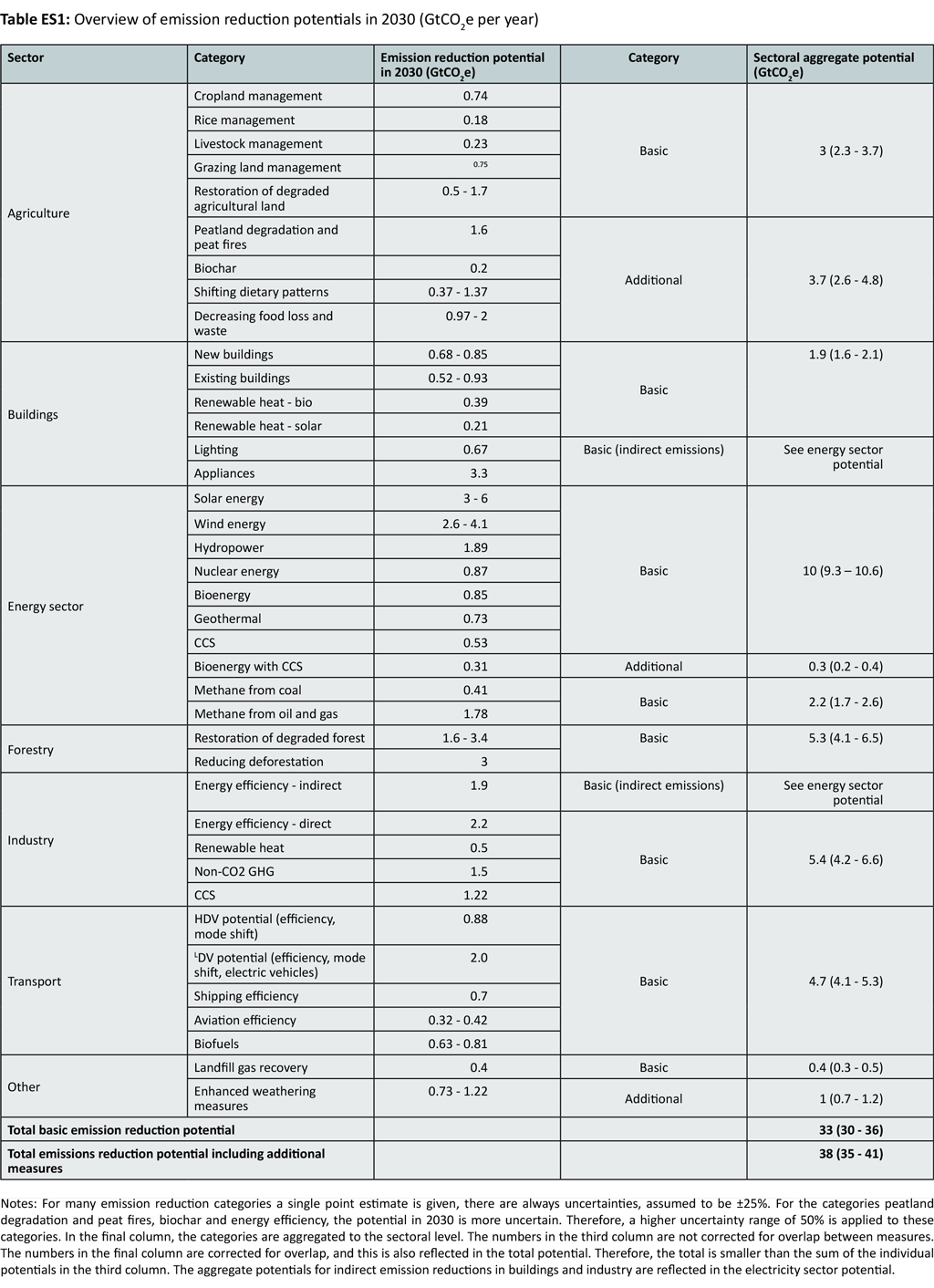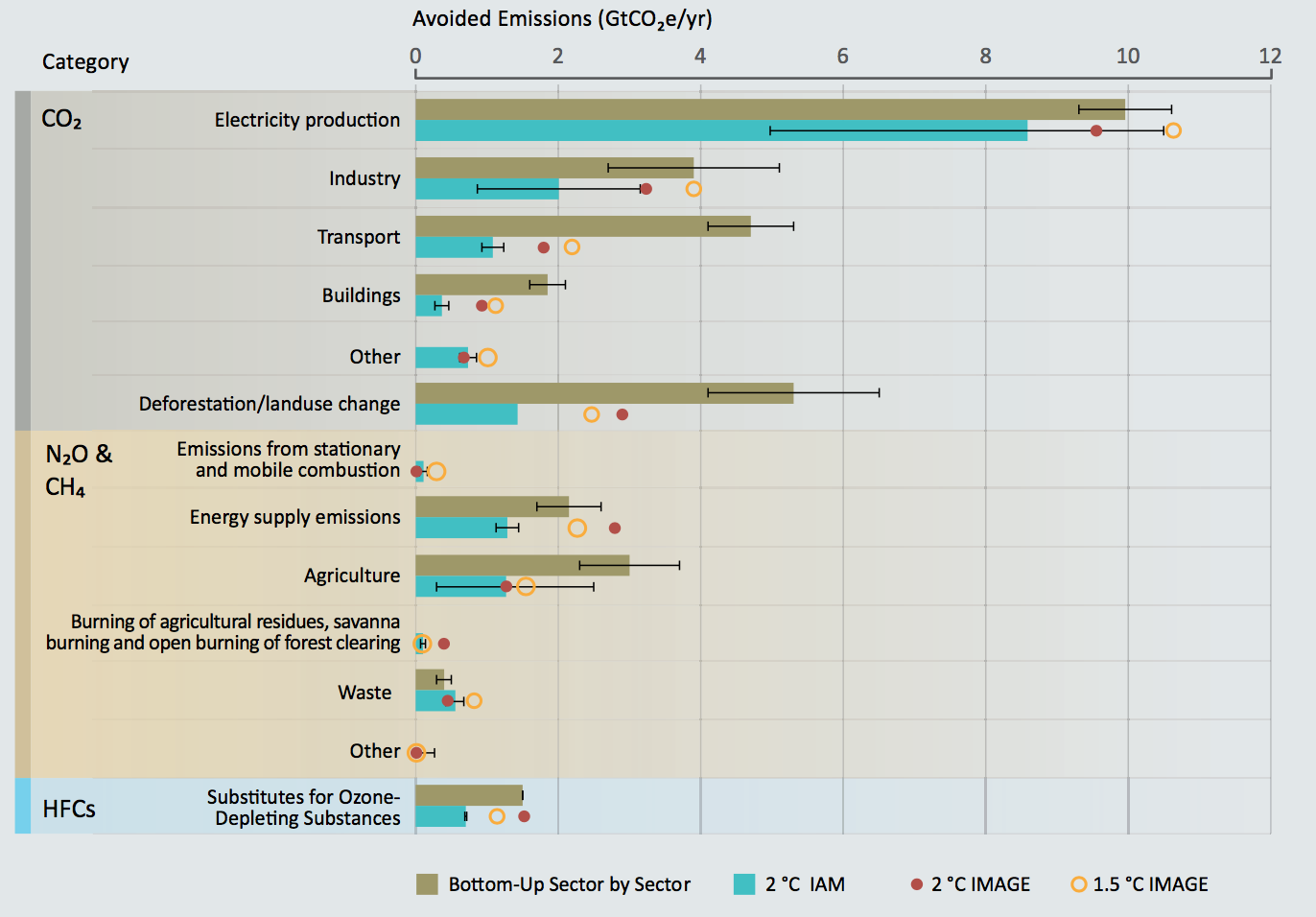
UNEP: Six crucial actions to help close the world’s ‘emissions gap’
Zeke Hausfather
10.31.17Zeke Hausfather
31.10.2017 | 10:45amCurrent pledges by nations to reduce their emissions add up to no more than a third of the reductions needed to avoid 2C of global warming, according to a new UN Environmental Program (UNEP) report.
This “emissions gap” is possible to close, it says, but countries need to take action quickly.
Much of this could be achieved collectively through focused action on just six key sectors, suggests UNEP.
The latest annual report, the eighth in the series, states that there is a “catastrophic climate gap” between the existing Paris Agreement commitments up to 2030 and the reductions required to avoid the worst consequences of global warming.
UNEP finds that even if current national commitments are fully implemented, the carbon budget for limiting global warming to below 2C will be about 80% depleted by 2030. The carbon budget for 1.5C is already largely depleted, though a much-debated recent paper argued that these allowable carbon budgets may be larger.
UNEP warns that the upcoming 2020 revision of nationally determined contributions (NDCs) may represent the “last opportunity” for the international community to commit to the level of reductions required to avoid 2C warming.
The report does stress some reasons for hope, though. It notes that global greenhouse emissions fell slightly in 2016. Furthermore, CO2 emissions from fossil fuels have been nearly flat since 2013. Non-state actors, such as cities, regional governments and companies, may play a growing role in helping reduce the emission gap.
UNEP presents analysis suggesting that the gap can still be closed before 2030 by adopting already known and cost-effective technologies and best-practices across different sectors.
In fact, it says: “It is remarkable that a large part of this potential comes from just six relatively standardised categories.”
Here, Carbon Brief explains the key points made by UNEP in this year’s report. (Carbon Brief’s archives also include detailed coverage of the UNEP reports in 2014, 2015 and 2016.)
‘Alarmingly high’ gap
As part of the Paris Agreement, many countries proposed NDCs with emission reduction targets for 2025 or 2030. These new commitments, combined with existing national policies, result in a notable reduction in emissions and committed warming relative to a baseline that sees a world with no climate policy.
The figure below shows the UNEP’s baseline trajectory in red, along with the emissions that would result from current policies alone in yellow. NDCs that are conditioned on actions of other countries, as well as those that are unconditional, are shown in blue. Emission trajectories consistent with staying well below 2C and avoiding 1.5C are shown in purple and grey, respectively.
Median emission scenarios adapted from figure 3.1 in the UNEP Emission Gap Report 2017. Chart by Carbon Brief using Highcharts.Current NDC commitments only get the world roughly half of the way to 2C from the baseline trajectory – and only a third of the way toward a 1.5C trajectory. This leaves a gap of 11-13 gigatonnes CO2-equivalent (GtCO2e) to get to a 2C trajectory, and a gap of 16-19 GtCO2e to get to a 1.5C trajectory.
![]()
UNEP uses a scenario that is “well below 2C”, meaning that there is an estimated 66% chance of avoiding more than 2C warming. For 1.5C, however, it uses a scenario that only has a 50/50 chance of avoiding 1.5C. It suggests that too few studies were available showing a plausible path to 66% chance of avoiding 1.5C to merit inclusion this year, but that a more aggressive (and even more difficult to achieve) scenario may be included in the 2018 report.
Despite the large emission gap, there is some positive news contained in this figure. Current policies plus NDCs move the world away from the baseline scenario associated with some of the worst impacts of climate change. While long-term emission trajectories consistent with the Paris commitments would still commit the world to around 3C warming without additional reductions, it would make the chance of getting 4C or more warming considerably smaller.
Emissions remain flat
While it is too soon to say that global emissions have turned a corner and begun to decline, the past three years do show signs that the growth of emissions may have slowed or stopped.
This marks a notable reversal of the rapid year-on-year increases seen over the past few decades. This might indicate a decoupling of energy- and industry-related emissions from economic growth. Annual emissions by country are shown in the UNEP figure below, both for all greenhouse gases (left) and CO2 emissions from fossil-fuel use (right).

Figure 2.1 in the UNEP Emission Gap Report 2017. Emissions are shown in gigatons CO2-equivalent per year. Source: UNEP.
The UNEP report identifies reduced growth and declines in coal use since 2011 as one of the major drivers of the decline, with notable reductions both in China and the US. Additional factors include growing renewable energy use, especially in China and India, as well as enhanced energy efficiency and structural changes in the global economy.
Closing the gap
While the size of the gaps between the NDCs and the 2C or 1.5C trajectories are large, the UNEP report suggest that they still can be closed in a cost-effective manner. The report presents an analysis of the contributions that different sectors of the global economy can make, through adopting existing cost-effective technologies and employing best practices already being deployed in some countries.
The report says that “it is remarkable” that a large portion of reductions come from just six specific things: solar energy; wind energy; efficient appliances; efficient passenger cars; aforestation; and stopping deforestation. It says:
“These six categories sum up a potential of 18.5 GtCO2e in 2030 (range: 15-22 GtCO2e), making up more than half of the basic potential. Equally important, all these measures can be realised at modest cost, and are predominantly achievable through proven policies.”
The report includes a detailed table (below) showing the “emission reduction potentials” in 2030 of each category within each sector. The largest two individual categories listed are solar energy (3-6 GtCO2e) and wind energy (2.6 – 4.1 GtCO2e).

Figure 4.1 in the UNEP Emission Gap Report 2017. Emissions are shown in gigatons CO2-equivalent in 2030. Source: UNEP.
![]()
Another figure in the report (below) shows an alternative way of viewing these sectoral contributions. It compares the report’s “bottom-up” sector-by-sector assessment above with the sectoral emissions as reported by a range of leading integrated assessment models (IAMs).
The bottom-up analysis is shown in brown. Prior integrated assessment modelling results are shown by the blue bars and red and orange circles. The costs of all of these reductions are estimated to be below US$100 per tonne CO2e.

Figure 4.2 in the UNEP Emission Gap Report 2017. Avoided emissions (in 2030) are shown in gigatons CO2-equivalent per year. Source: UNEP.
Most of the reductions come from the power sector, but sizable reductions also come from industry, forestry, transport, agriculture and buildings. Reducing emissions of fugitive methane from the energy supply and N2O from agriculture are also an important part of closing the gap.
The Kigali Amendment to phase out the production of hydrofluorocarbons, signed in 2016, is also highlighted, with the agreement estimated to reduce annual emissions by around 0.7 GtCO2e in 2030 compared to current policies.
Action by subnational and non-state actors, including regional and local governments and businesses, are seen as an increasingly important part of closing the emissions gap. While the extent of additional reductions that can be achieved by these groups outside of national commitments is unclear, they may play a large role in helping the US, in particular, achieve reductions in the absence of federal action under the Trump administration.
Negative emissions
Finally, the report suggests an important role for negative emissions technologies. It examines a number of different technologies including afforestation and reforestation, land management changes to increase soil carbon, and technological approaches, such as bioenergy with carbon capture and storage and direct air capture.
Technological approaches will likely have a relatively small role to play in the early part of the century as they remain far from cost-effective to deploy at scale, but may play a much larger role in later emission reductions, the report notes. It argues that it remains uncertain whether these technologies can be scaled up to achieve the ambitious climate targets. Therefore, mitigation in other sectors should not be delayed in the hope that cheap carbon dioxide removal technologies will be available in the future.

